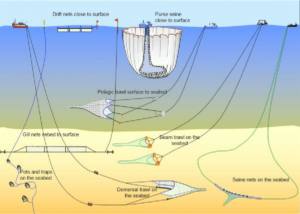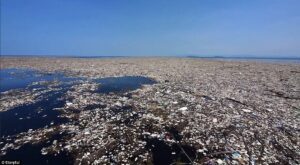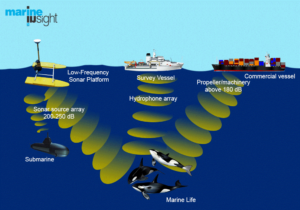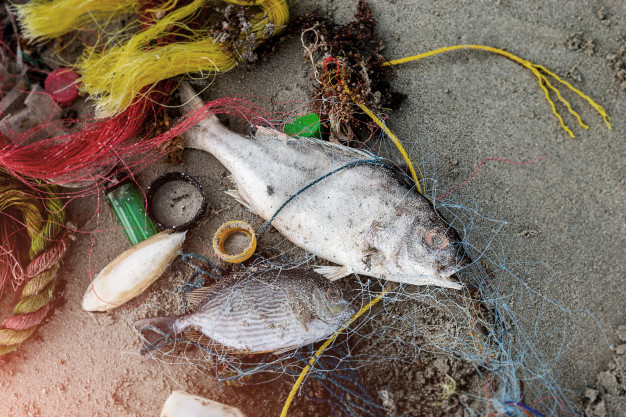Habersaat Michel
October 2020
The Ocean is in very bad health. It has a short breath, reflux of acidity, and feels empty. It is quite annoying as it represents 71% of the world’s surface and is responsible for 50% of the atmospheric dioxygen. It is time to come up with a cure.
The diagnosis is alarming (see bibliography below) and the cure will be about restriction and discipline rather than a huge cleaning through technology. I know it is tempting to think that robots, AI, 5G, and whatever will save the world like in a movie. However, these are just distractions and it is time to come up with a real therapy which can only be applied by changing certain habits.
Here is a list of 5 prescriptions to cure the Ocean. Let’s have a look!
- A drastic diet to end overfishing
According to the FAO, 20 million tons of fishes were captured in 1950 and 96.4 million tons in 2018 (FAO 2018). We can’t continue to consume marine products at this rate. Huge trawl nets are so efficient that they don’t leave any chance to their preys. The worst is that a lot of these fishes are captured for nothing. They are uneatable and don’t interest the fishermen who throw them away. Also, as the demersal net or dredge case scrap the ocean floor, it embarks everything: turtles, sponges, corals, and many more. So many species are now threatened, in danger of extinction, or trespassing due to these irresponsible fishing practices. This sacrifice is worthless!
How to solve the problem?
Fishermen need to reduce their catch and for that we need to come up with local, national, and international protective laws. As an example, electric pulse fishing, another very efficient fishing method which doesn’t leave any chance to its preys, is already banned in most of the world and will be forbidden in European Nations by 2021[1]. But it isn’t enough. We also need to implement non-fishing corridors across the ocean and fight against Illegal fishing which represents about 15% of all catch (Agnew et al. 2009). Also, we need to adopt better fishing practices by abolishing trawl nets, drift nets, or demersal nets that catch everything without any distinctions.
Aquaculture is a good alternative to provide us with the protein we need while living the Ocean in peace. Finally, the fishes we buy in the stores or in the markets should be traceable to make sure that their origin isn’t from a wrong fishing practice. The consumer would then become aware and responsible of what he eats.

Figure 1. Summary of commonly used commercial fishing gears. A drift net can be up to 50 km long while the Pelangres drift can reach up to 200 km. Other harmful methods include the long line with up to 1000 of hooks in over 80 km or the electric fishing that kills anything touching the current. Source : https://www.researchgate.net/figure/Summary-diagram-of-various-types-of-commonly-used-commercial-fishing-gears-seafishorg_fig2_269629387
- A cure of detoxification to stop plastics
Eight million tons of plastics are ending up into the ocean every year (Parker 2015). Most of them enter the ocean on a form of micro-plastics ranging from a size of 5 millimeters or less. These microplastics are absorbed by the smallest organisms in the bottom of the food web and then come up to the turtles or other larger organisms where they cumulate.
There are some biodegradable plastics available on the market now. However, they degrade at a temperature of around 60°C. These plastics may stay for a very long time into the ocean. One of the promising developments in the plastic industry is a polyhydroxyalcanoates produced by bacteria which decomposes well into the sea (Kovalcik 2019).
Many projects to clean up the Ocean are being held. However, we didn’t assist to a real breakthrough that may depollute the water. We really need to work inland in order to prevent further plastic dumping into the Ocean. Therefor we need to be more responsible over our waste and its destination.

Figure 2. Plastics are moved by oceanic currents and tend to cumulate in certain specific area of the Ocean as here in the Caribbean Sea. Source: https://en.mogaznews.com/Technology/720018/Video-shows-Caribbean-sea-choked-to-death-by-human-waste.html
- Drop the temperature for a better oxygenation
The level of dioxygen dissolved into the Ocean is dropping down. The number of dead zones is rising up. Whenever they can, fishes are swimming away from these zones, but the species that can’t move have no other choice than to pass out.
The remedy is to drop down the atmospheric temperature. The Ocean is responsible to absorb around 90% of heat entering the atmosphere (Holden 2020) and in this regard is becoming another victim of global warming. Warmer water absorbs less dioxygen. Also, the dioxygen tends to be “lighter” under warmer condition and doesn’t diffuse down so easily to mix with deep water.
Our consumption in fossil fuel to run our industry, transport, and many more is largely responsible for this global warming. The solution to cooler temperatures lies in the development and consumption of sustainable forms of energy. Be aware and responsible consumer!
On the coast, the runoff of agricultural fertilizers led to series of algae bloom. Their massive decomposition is sucking out all the dioxygen in their surroundings. In order to contain this unnecessary supply of fertilizers, we need to plant more trees along the coast that will act as filters. We also need better water treatments and to adopt a more responsible form of agriculture with less of such externalities. Finally, we should provide some protected zones for marine life to take refuge from these spoiled areas.

Figure 3. Algae bloom in China (Quindao). The algae block the sunlight causing the death of many organisms. Their decomposition deprives the sea shore of dioxygen. Source: https://www.nydailynews.com/news/world/algae-bloom-qingdao-china-mystery-poses-threat-marine-life-coastline-tourism-article-1.160045
- A cure of vegetal to reduce the acidity
The pH is decreasing; the water becomes more acidic. The Ocean absorbs about a third of CO2 emissions. It’s good news against global warming but it’s a bad one for the pH. The CO2 combines with water to form an acidic carbonate. Models show that the Ocean’s pH already dropped from 8,2 to 8,1 since the industrial revolution (Winner 2010). It is a lot more important than it appears because the pH scale is logarithmic which means that a change in 1 degree makes a difference of 10x the previous value. Therefore, the Ocean is 30% more acid at 8,1 than it is at 8,2 and the forecast shows that the pH will drop to 7,8 by 2100. More acidic water will affect the formation calcium-based shelves or skeleton of small invertebrates, zooplanktons, and corals. These animals are at the base of their ecosystems. Therefore, if they are affected, all will be affected.
The solution relies on reducing the amount of CO2 in the atmosphere and in the Ocean alike. One of the ideas would be to restore mangrove ecosystem and Posidonia marine prairies along the coasts where it disappeared. These plants have the capacity to absorb and store a lot of carbon dioxide.
- A silence therapy to preserve the marine fauna
There is too much noise in the Ocean. It doesn’t seem like much, but now we understand that it is a real perturbance for the marine life (Smita 2020). It affects their sense of orientation. It also perturbates their communication and reproduction. They find more difficult to hunt preys and avoid predators. It is really a big problem!
At this point, Humanity needs to be more discreet. There are ways to isolate the noise of our machines. They have to be integrated into modern marine equipment and the older machines should be sent to area where they disturb less.

Figure 4. Sound pollution is another major threat to marine life. Source: https://www.marineinsight.com/environment/effects-of-noise-pollution-from-ships-on-marine-life/
Bibliography
Agnew DJ, Pearce J, Pramod G, et al. (2009) “Estimating the Worldwide Extent of Illegal Fishing”. PLoS ONE 4(2): e4570. https://doi.org/10.1371/journal.pone.0004570
Holden Emily (2020) “Temperature of deepest ocean rising quicker than previously thought”. The Guardian. https://www.theguardian.com/environment/2020/oct/14/enormous-amount-of-heat-even-deepest-ocean-is-warming-study
FAO (2018) Fishery and aquaculture statistics. Yearbook. Pp xxiv, 83
Kovalcik A, Obruca S, Fritz I, et al. (2019). “Polyhydroxyalkanoates: Their importance and future“. BioRes 14(2), 2468-2471.
McGrath Matt (2019) “Climate change: ocean running out of oxygen as temperatures rise”. BBC News. https://www.bbc.com/news/science-environment-50690995
Parker Laura (2015) “Eight million tons of plastics dump into the ocean every year”. National Geographic. https://www.nationalgeographic.com/news/2015/2/150212-ocean-debris-plastic-garbage-patches-science/
Smita (2020) “Effects of noise pollution from ships on marine life”. Marine Environment. https://www.marineinsight.com/environment/effects-of-noise-pollution-from-ships-on-marine-life/
Winner Cherie (2010) “A small drop in pH means a big change in acidity”. Oceanus. https://www.whoi.edu/oceanus/feature/small-drop-in-ph-means-big-change-in-acidity/
[1] Europe bans electric fishing by 2021: https://www.euractiv.com/section/agriculture-food/news/eu-approves-ban-on-electric-pulse-fishing-from-2021/



